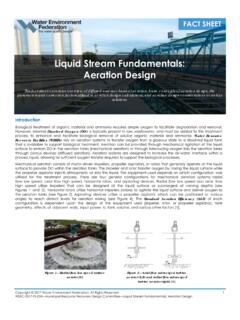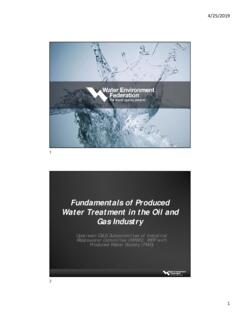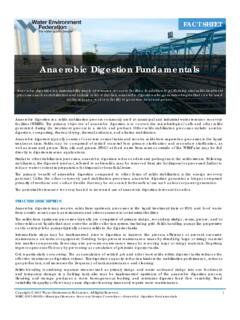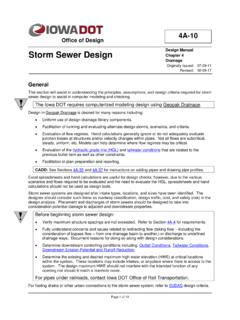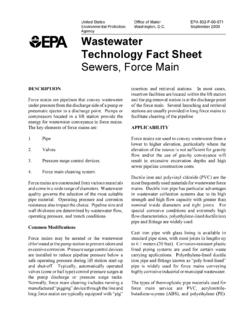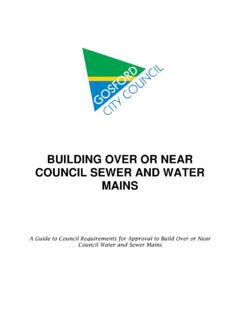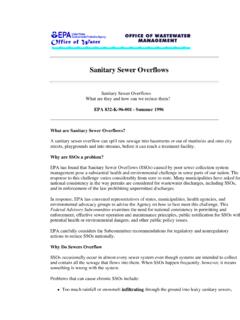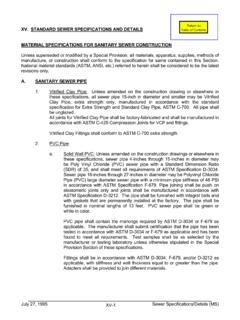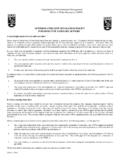Transcription of Sanitary Sewer Rehabilitation - Water Environment Federation
1 Introduction Sewers are a series of connected pipes or pipelines that convey either wastewater or storm Water to a designated downstream location for treatment and/or disposal. There are three different types of sewers: Sanitary , storm and combined. Sanitary sewers and combined sewers convey wastewater from homes, institutions and businesses to a centralized treatment plant. Sanitary sewers carry only wastewater whereas combined sewers carry both wastewater and storm Water . Wastewater conveyance and treatment are important because they help prevent waterborne illnesses and promote general sanitation before safely discharging to receiving waters. Many older Sewer systems consist primarily of combined sewers in the central or older part of the city but are surrounded by Sanitary sewers built in newer growth areas.
2 Storm sewers convey snowmelt and rainwater from yards, sidewalks and roadways and route it to receiving waters directly or through best management practices and facilities to remove certain pollutants. Sanitary and combined Sewer systems usually contain private Sewer laterals that connect individual buildings to main Sewer pipelines. However, Sanitary and combined sewers include more than just pipes. The pipes are part of an entire conveyance system that includes pump stations, force mains, manholes, storage facilities and other components. Similarly, storm Sewer conveyance systems can also include pump stations, force mains, manholes and storage facilities. WEF s Sanitary Sewers fact sheet provides an overview of Sanitary Sewer basics, design, operation and maintenance, as well as repair / Rehabilitation / replacement issues.
3 This fact sheet provides Sanitary Sewer Rehabilitation information, methods and references. The primary focus of this fact sheet is Rehabilitation of the Sanitary Sewer mainline located in the public right-of-way or dedicated easement. In addition, it provides basic information on Rehabilitation of private Sewer laterals that connect homes/buildings to the Sewer mains in the public right-of-way. Sanitary Sewer Defects and Extraneous Flow Sewers are designed to collect wastewater from intended sources and convey it downstream. However, some extraneous Water may enter the pipes from unintended sources, either from surface Water , groundwater through defects or direct illicit connection.
4 Sewer defects are pipe system deficiencies resulting from system aging, structural failure, lack Copyright 2017 Water Environment Federation . All Rights Reserved. 1 WSEC-2017-FS-009 Collection Systems Committee Sanitary Sewer Rehabilitation Fact Sheet Sanitary Sewer Rehabilitation Sanitary Sewer Rehabilitation through repair and renewal is a common practice to reduce extraneous flow, and address structural defects. This fact sheet serves as a basic resource for practitioners providing Rehabilitation information, methods and key industry references. FACT SHEET Figure 1: Typical Sources of I/I in Sanitary Sewer Systems (Image from WEF, 2017) of proper maintenance, and/or poor construction and design practices.
5 They can include conditions such as broken pipe; leaking joints; manhole lids with holes and/or poor sealing; and root infested Sewer laterals (See Figure 1). In Sanitary sewers, this can lead to excessive infiltration and inflow (I/I), which can be more noticeable after precipitation conditions. Extraneous Water entering any collection system can consume some or all the available capacity as originally designed. These additional flows have a significant impact in relatively small Sanitary sewers since they are sized to collect wastewater flow, not storm Water . When the available capacity is reduced, or consumed, Water levels rise and surcharging can occur.
6 Surcharging, when the Water level exceeds the height of the pipe, can accelerate pipe deterioration by forcing Water to leave the pipe through defects into surrounding soil, and bringing in surrounding soil when the surcharge is alleviated, causing voids to form outside the pipe. Surcharging can lead to Sanitary Sewer overflows (SSOs) either in the street or into buildings, and surface flooding. I/I entering Sanitary sewers is the highest level of concern. Sewer laterals, which connect buildings on private properties to Sewer mains, are often a significant source of I/I (See Figure 2). A comprehensive I/I reduction program requires effectively addressing private property I/I (PPII) sources.
7 Private property laterals can account for half of the I/I entry to Sanitary sewers. WEF s Private Property Infiltration and Inflow fact sheet outlines key considerations for municipal utilities establishing a framework for PPII mitigation activities such as program approaches, policy and legal issues, funding, public outreach, and implementation. Sewer Rehabilitation , or restoring to an improved condition, is a means to reducing the extraneous flow entering the system, which in turn lowers the potential for causing SSOs and flooding by correcting defects. Sewer defects can also be structural in nature and Rehabilitation can be necessary to prevent structural failure. Increasing extraneous flow is one symptom of the poor structural condition of aging sewers in many cases.
8 Hence, the Sewer Rehabilitation provides a solution to extend the useful life of the asset. Consequently, Rehabilitation can result in reduction of extraneous flow which in turn reduces Sewer surcharges and unintended poor system performance. The state-of-the-art industry experiences indicate that before investing in Sanitary Sewer capacity improvements to handle excessive I/I, it is prudent to improve Sewer system structural conditions to realize practical levels of I/I reduction first and then consider supplementing with right-sized conveyance/storage and downstream treatment systems. It has also been proven that asset management approaches to Sewer system Rehabilitation are effective and adding extraneous (I/I) flow reduction criteria will bring overall comprehension to prioritize public investments.
9 Reducing I/I is a foundational step before adding additional Sewer assets. Moreover, reducing PPII is critical for overall success of I/I reduction efforts. Rehabilitating the Sewer system should be undertaken first to determine the magnitude of I/I reduction possible. It may be that partial or comprehensive Rehabilitation of the system restores adequate levels of the conveyance capacity. Additional conveyance/storage/treatment capacity should be supplemented as needed. Sanitary Sewer Rehabilitation Sewer Rehabilitation can be considered both repair and renewal, to reduce extraneous flow, and address structural defects. Rehabilitation is different from system replacement in that repairs selectively target I/I sources and structural defects rather than complete replacement of pipes and/or manholes.
10 Not all Sewer defects cause capacity restrictions or are considered I/I sources. Copyright 2017 Water Environment Federation . All Rights Reserved. 2 WSEC-2017-FS-009 Collection Systems Committee Sanitary Sewer Rehabilitation Fact Sheet Figure 2: Example Sewer Lateral Configuration (Image from WEF, 2016) Repairs are generally made to allow the pipe to function to the end of its useful life. They can involve location specific repairs that seal the Sewer pipeline and may restore the structural integrity of the pipe at that location, but does not restore the structural integrity of the entire pipe. It can include repair methods that seal the entire pipe segment but do not restore structural integrity.
